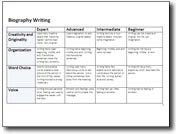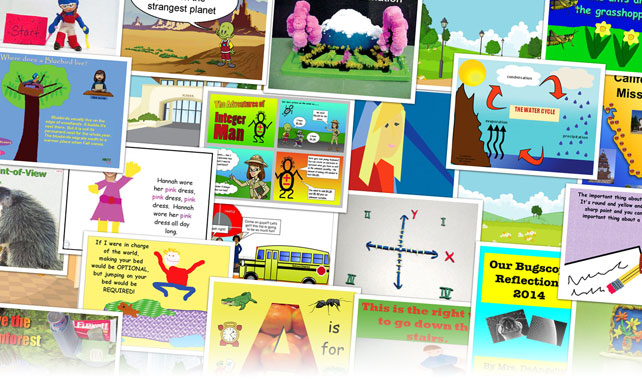
Techniques to evaluate progress and ensure success

Project work challenges students to think beyond the boundaries of the classroom, helping them develop the skills, behaviors, and confidence necessary for success in the 21st-century. Designing learning environments that help students question, analyze, evaluate, and extrapolate their plans, conclusions, and ideas, leading them to higher–order thinking, requires feedback and evaluation that goes beyond a letter or number grade. The term “authentic assessment” is used to describe assessment that evaluates content knowledge as well as additional skills like creativity, collaboration, problem-solving, and innovation.
Authentic assessment documents the learning that occurs during the project-building process and considers the real-world skills of collaboration, problem solving, decision making, and communication. Since project work requires students to apply knowledge and skills throughout the project-building process, you will have many opportunities to assess work quality, understanding, and participation from the moment students begin working.
For example, your evaluation can include tangible documents like the project vision, storyboard, and rough draft, verbal behaviors such as participation in group discussions and sharing of resources and ideas, and non-verbal cognitive tasks such as risk taking and evaluation of information. You can also capture snapshots of learning throughout the process by having students complete a project journal, a self-assessment, or by making a discussion of the process one component of the final presentation.
As you design the project, it is helpful to begin with the end in mind. What performances do you want to see? Then, determine exactly how students will demonstrate each performance as they build a product or solve a problem to complete the task.
Most of our assessment focuses on content mastery. Techniques we are all familiar with include the evaluation of the final product and having students complete quizzes or tests. Other benchmarks for content mastery you can use include the number of citations a student references, amount and quality of research, use of experts, validity and effectiveness of arguments, meeting the topic, and answering the essential question.
Completing complex authentic projects that require collaboration, creativity, problem-solving, and innovation helps prepare students for increasingly complex life and work environments. Effective communication in the 21st-century requires that students can effectively express themselves in writing, verbally, and visually. Be sure to assess the quality of writing, including ideas, vocabulary, fluency, organization, and conventions, as well as the use of media and overall design. Since a project is a collaborative effort that occurs over time, include evaluation components that consider teamwork, organization, planning, and behavior.
Content Knowledge
Collaboration & Teamwork
Technology & Communication
Because many performances cannot easily be quantified, you want to be as specific about your expectations as possible. Creating a rubric for the final product and various components of project work can ensure a more accurate, specific, and useful assessment.
A rubric is an authentic assessment tool that:
Sharing and clarifying the performances that will be assessed during a project removes mystery from the evaluation process, helping students focus on specific actions they can take to improve their performance.

Involving students in project assessment boosts motivation, improves meta-cognition, and promotes self-directed learning. Students who are asked to reflect on their own performance learn to evaluate their strengths and weaknesses and are able to pinpoint where to focus their efforts to see the greatest results.
You might have students provide feedback and critiques by asking them to keep a project journal or work log, evaluate themselves using the project rubric, and answer additional self-assessment questions. An open-ended self-assessment allows students to share learning that occurred during the process that was not included in the rubric. As they reflect and evaluate, students should describe their learning and contemplate decisions they have made individually and as a team.
You may also want to have students complete a peer evaluation for components of the project, such as the project presentation. Students can also evaluate the writing, design, and effective communication during the creation and presentation of the final product. Combining your assessment of the process and the end product with student reflections and evaluations will help you create a more accurate assessment of student performance.
Authentic project work should reflect the questions, problems, and needs of the world beyond the classroom. If the work is something that has real value, make sure there is a wider audience for the final product presentation. Having students create web pages to display their ideas and findings enables their products to easily reach a wider audience. If the project deliverable involves an oral presentation, invite peers, family, or community members to attend.
You may also want to invite subject matter experts in the area of project work to participate in the final product’s assessment. Developing public-service announcements? Invite employees from a local advertising agency. Designing a new school? One of your classroom parents may just be an architect.

If students know that other people will be relying on and judging the information and ideas they propose, their motivation to work hard and take risks increases. If you involve the audience in the assessment process, be sure to provide a rubric or other guide to ensure the feedback they provide is pertinent to project goals.
The complexity of student projects makes assessment that captures both the final product and the learning that occurs along the way an intricate and sometimes difficult task. Summative assessment can be an effective component of an overall assessment strategy. Authentic assessment can be used during the project-building process. Rubrics, ideally developed with the help of the students, can help to evaluate how successfully students address specific goals and performances. Self-reflection gives students a means to determine what they think they have learned and how well they have learned it. Crafting assessment strategies that combine all of these methods helps us gain a much better understanding of the learning that takes place during the entire process.
Creative Educator can help you bring project-based learning to your school.
Learn More
What can your students create?

Wixie
Share your ideas, imagination, and understanding through writing, art, voice, and video.

Rubric Maker
Create custom rubrics for your classroom.

Pics4Learning
A curated, copyright-friendly image library that is safe and free for education.

Wriddle
Write, record, and illustrate a sentence.
Topics